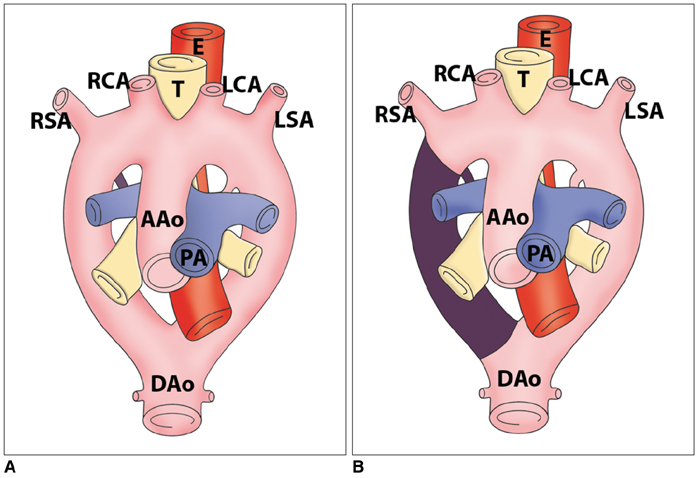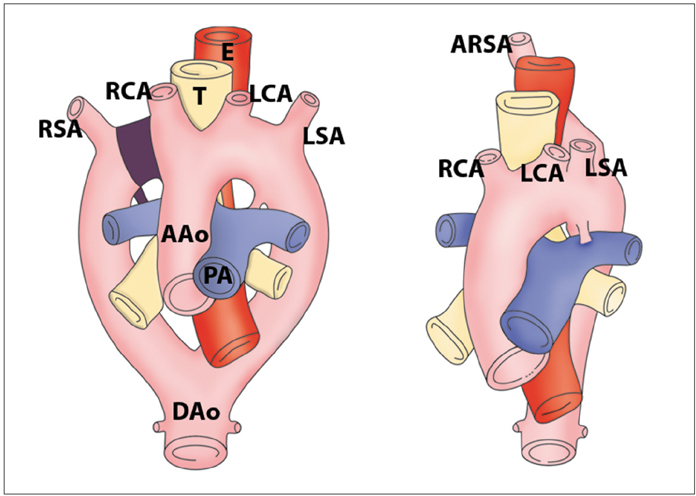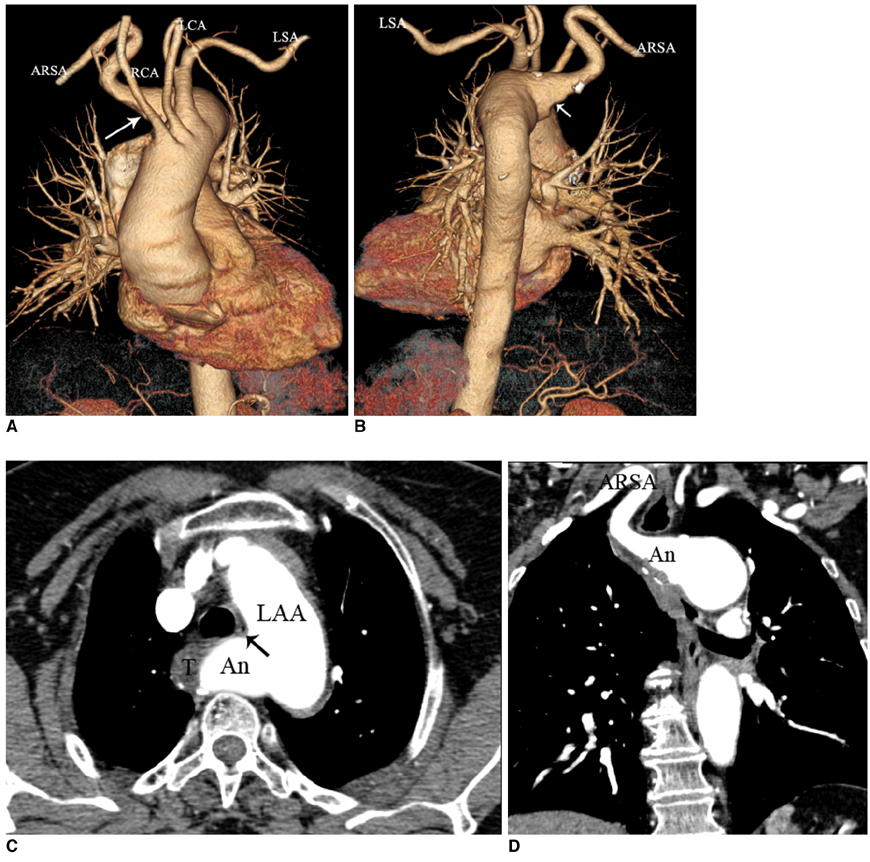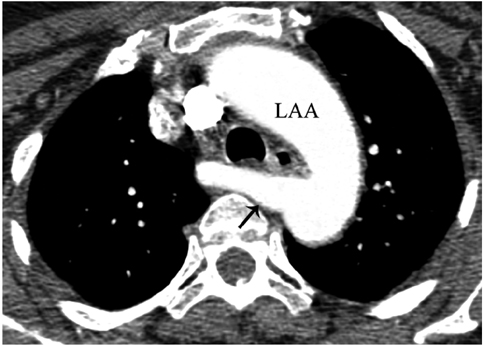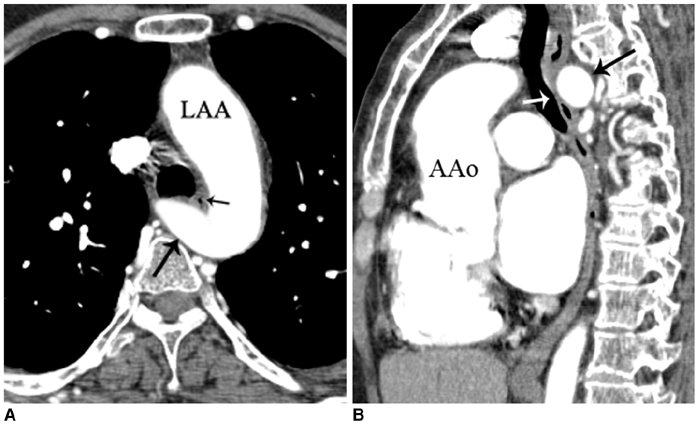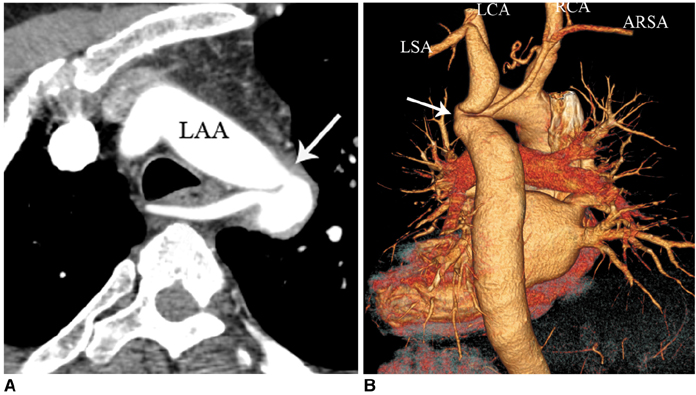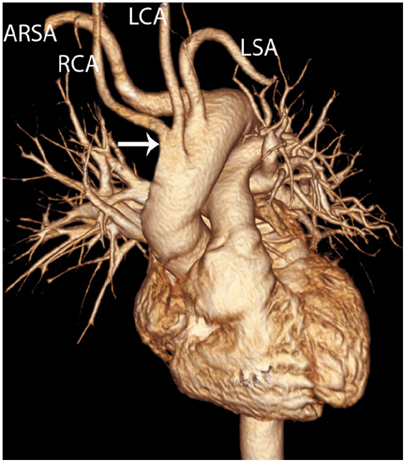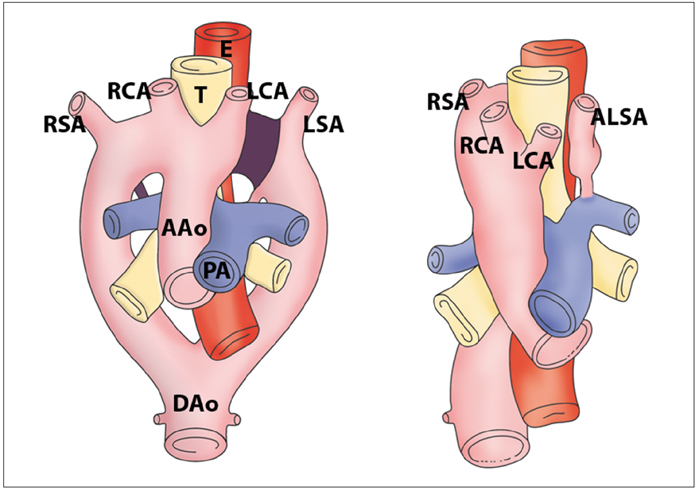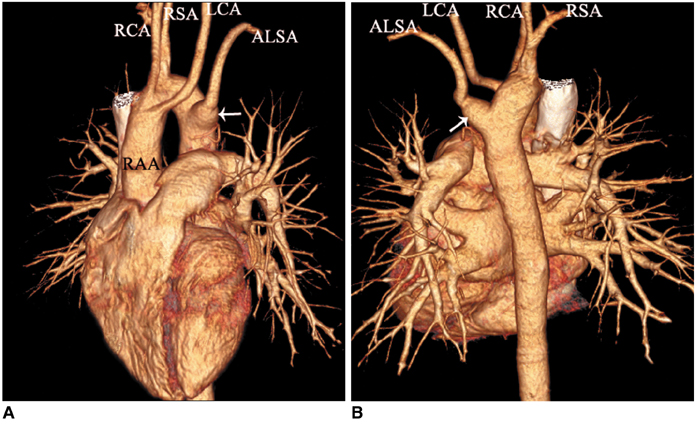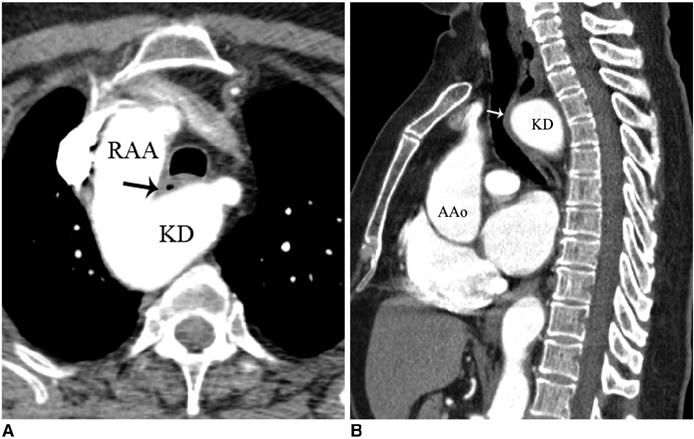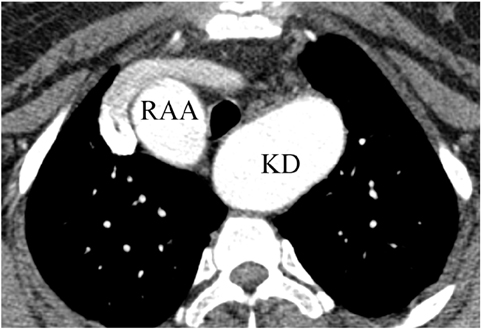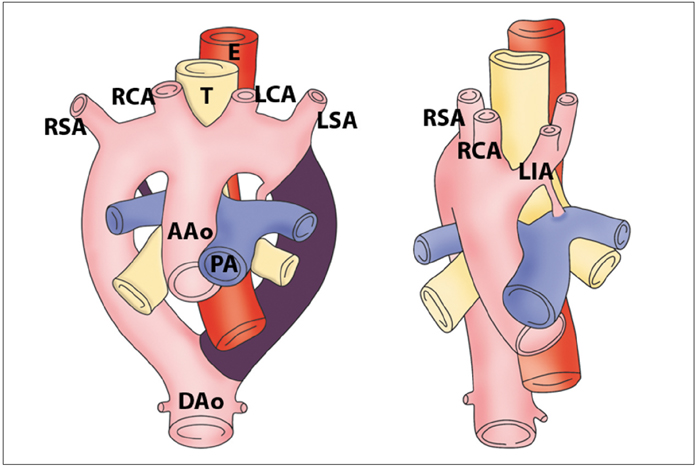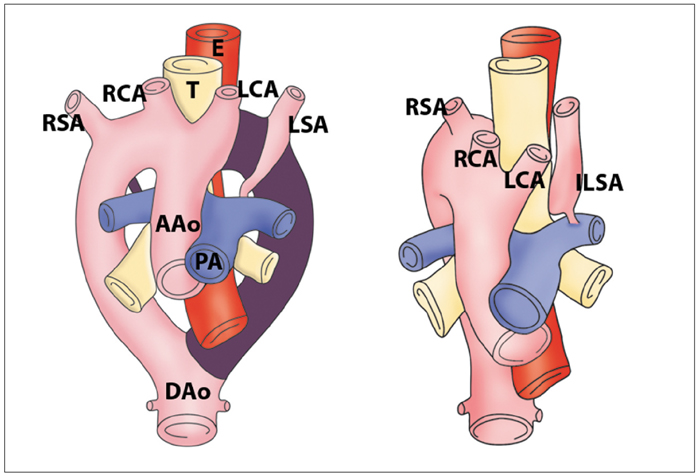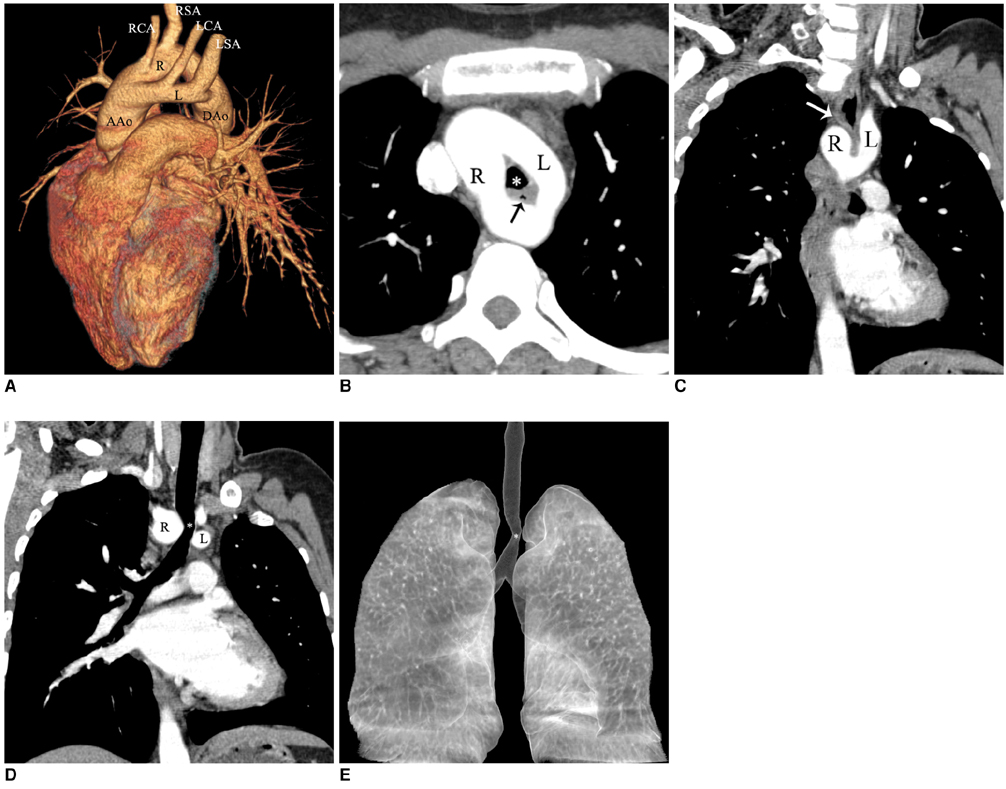Korean J Radiol.
2009 Apr;10(2):176-184. 10.3348/kjr.2009.10.2.176.
Congenital Anomalies of the Aortic Arch: Evaluation with the Use of Multidetector Computed Tomography
- Affiliations
-
- 1Department of Radiology, TurkIye Yuksek Ihtisas Hospital, Ankara, Turkey. aturkvatan@yahoo.com
- KMID: 1088729
- DOI: http://doi.org/10.3348/kjr.2009.10.2.176
Abstract
- Congenital anomalies of the aortic arch have clinical importance, as the anomalies may be associated with vascular rings or other congenital cardiovascular diseases. Multidetector computed tomography (MDCT) angiography enables one to display the detailed anatomy of vascular structures and the spatial relationships with adjacent organs; this ability is the greatest advantage of the use of MDCT angiography in comparison to other imaging modalities in the evaluation of the congenital anomalies of the aortic arch. In this review article, we illustrate 16-slice MDCT angiography appearances of congenital anomalies of the aortic arch.
MeSH Terms
Figure
Reference
-
1. Grathwohl KW, Afifi AY, Dillard TA, Olson JP, Heric BR. Vascular rings of the thoracic aorta in adults. Am Surg. 1999. 65:1077–1083.2. Lee EY, Siegel MJ, Hildebolt CF, Gutierrez FR, Bhalla S, Fallah JH. MDCT evaluation of thoracic aortic anomalies in pediatric patients and young adults: comparison of axial, multiplanar, and 3D images. AJR Am J Roentgenol. 2004. 182:777–784.3. Gilkeson RC, Ciancibello L, Zahka K. Multidetector CT evaluation of congenital heart disease in pediatric and adult patients. AJR Am J Roentgenol. 2003. 180:973–980.4. Edwards JE. Anomalies of the derivatives of the aortic arch system. Med Clin North Am. 1948. 32:925–949.5. Stewart JR, Kincaid OW, Edwards JE. An atlas of vascular rings and related malformations of the aortic arch system. 1964. Illinois: Springfield;12–131.6. Fisher RG, Whigham CJ, Trinh C. Diverticula of Kommerell and aberrant subclavian arteries complicated by aneurysms. Cardiovasc Intervent Radiol. 2005. 28:553–560.7. Tsai IC, Tzeng WS, Lee T, Jan SL, Fu YC, Chen MC, et al. Vertebral and carotid artery anomalies in patients with aberrant right subclavian arteries. Pediatr Radiol. 2007. 37:1007–1012.8. Backer CL, Ilbawi MN, Idriss FS, DeLeon SY. Vascular anomalies causing tracheoesophageal compression. Review of experience in children. J Thorac Cardiovasc Surg. 1989. 97:725–731.9. Hastreiter AR, D'Cruz IA, Cantez T, Namin EP, Licata R. Right-sided aorta. Part I. Occurrence of right aortic arch in various types of congenital heart disease. II. Right aortic arch, right descending aorta, and associated anomalies. Br Heart J. 1966. 28:722–725.10. Luetmer PH, Miller GM. Right aortic arch with isolation of the left subclavian artery: case report and review of the literature. Mayo Clin Proc. 1990. 65:407–413.11. Pearson GD, Kan JS, Neill CA, Midgley FM, Gardner TJ, Hougen TJ. Cervical aortic arch with aneurysm formation. Am J Cardiol. 1997. 79:112–114.12. Goo HW, Park IS, Ko JK, Kim YH, Seo DM, Yun TJ, et al. CT of congenital heart disease: normal anatomy and typical pathologic conditions. Radiographics. 2003. 23:S147–S165.13. Dillman JR, Yarram SG, D'Amico AR, Hernandez RJ. Interrupted aortic arch: spectrum of MRI findings. AJR Am J Roentgenol. 2008. 190:1467–1474.
- Full Text Links
- Actions
-
Cited
- CITED
-
- Close
- Share
- Similar articles
-
- Aortic Arch Variants and Anomalies: Embryology, Imaging Findings, and Clinical Considerations
- Evaluation of congenital anomalies of the aortic arch by CT and MRI
- Congenital Variants and Anomalies of the Pancreas and Pancreatic Duct: Imaging by Magnetic Resonance Cholangiopancreaticography and Multidetector Computed Tomography
- Anomalous Origin of the Left Circumflex Coronary Artery from the Right Sinus of Valsalva Identified by Imaging with Multidetector Computed Tomography
- True Tracheal Bronchus: Classification and Anatomical Relationship on Multi-Detector Computed Tomography

